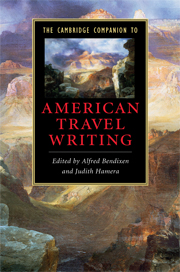Book contents
- Frontmatter
- Introduction: new worlds and old lands - the travel book and the construction of American identity
- Part I Confronting the American landscape
- Part II Americans abroad
- Part III Social scenes and American sites
- 11 African American travel literature
- 12 American women and travel writing
- 13 Driving that highway to consciousness: late twentieth-century American travel literature
- Chronology
- Further Reading
- Index
12 - American women and travel writing
from Part III - Social scenes and American sites
Published online by Cambridge University Press: 28 March 2009
- Frontmatter
- Introduction: new worlds and old lands - the travel book and the construction of American identity
- Part I Confronting the American landscape
- Part II Americans abroad
- Part III Social scenes and American sites
- 11 African American travel literature
- 12 American women and travel writing
- 13 Driving that highway to consciousness: late twentieth-century American travel literature
- Chronology
- Further Reading
- Index
Summary
Americans have the reputation of always being on the move. Early in our nation's history, French visitor Michel Chevalier commented that “[The American] has no root in the soil, he has no feeling of reverence, and love for the natal spot and the paternal roof; he is always disposed to emigrate, always ready to start in the first steamer that comes along, from the place where he had but just now landed.” Our national identity and literature are marked by the lore of the open road, of “landscapes of continents and the public road,” as Walt Whitman celebrated. And our heroes are the explorers and restless souls whose tales of new lands, adventure, freedom, and opportunity form a part of the national myth: Columbus, the 49ers, Huck Finn, Jack Kerouac. But women too traveled, migrated, moved, often for the same reasons as their husbands, brothers, and fathers. As Annette Kolodny observes of pioneer women who moved West, “Like their husbands and fathers, women too shared in the economic motives behind emigration, and like the men, women also dreamed of transforming the wilderness. But the emphases were different.” The reasons women travel may be similar to the motivations that drove men to journey, but the degree to which their choice of travel is free, the kinds of experiences they relate, and the metaphysical roads they travel can be quite different. “The road of the [female] nomad,” Deborah Paes de Barros claims, “is not simply traveled in a different manner . . . It is a new space, a space between borders . . .” Even though women have shared in experiences of travel with men, much of the critical attention to travel has focused on the male traveler or a male paradigm of travel.
- Type
- Chapter
- Information
- The Cambridge Companion to American Travel Writing , pp. 214 - 227Publisher: Cambridge University PressPrint publication year: 2009
- 11
- Cited by

